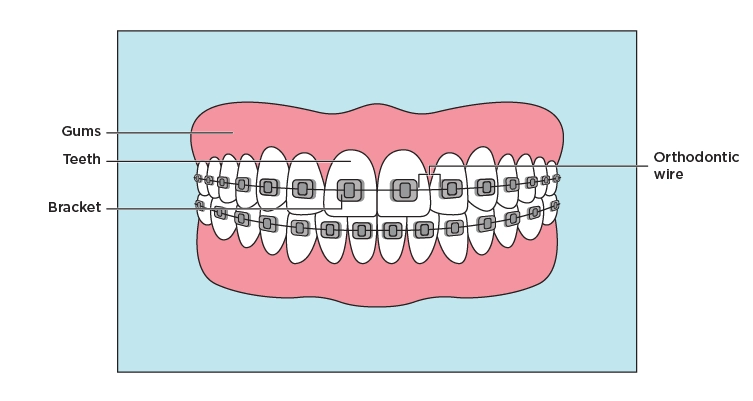What are dental braces?
Braces are dental orthodontic appliances used to straighten teeth and align your bite. These devices help to restore smile confidence and improve one’s dental health.
How do braces work? They fix problems with tooth and jaw alignment by exerting light constant pressure on the tooth roots for an extended period of time. This causes the bone around the root to change so that the tooth can move into a new position. This process is done very slowly so that the jawbone can adapt and reshape around the new bite position. Once treatment is complete and braces are removed, a retainer is usually worn until the teeth are completely settled into their new location.
Types of braces
If you do choose to get braces, thanks to modern technology, there are now many types to choose from. Here are some options that are offered:
- Traditional braces – These devices consist of stainless steel brackets that attach to the front of the teeth. The brackets are then accompanied by light wires that attach to the brackets with tiny rubber bands.
- Ceramic braces – These appliances work just like traditional braces, except the brackets used are ceramic. Brackets can be clear or tooth colored, if you want them to be less noticeable, and they also come in a variety of color options, should you like to make a statement.
- Lingual braces – Like most other braces, these devices employ brackets and wires to correct issues with alignment. However, the brackets are attached to the inside of the teeth. This kind of brace is typically elected by people that don’t want their braces to show when they smile. Lingual braces:
- Cost more because they are usually custom-made in a dental laboratory to fit the backs of your teeth.
- Usually require more time at each adjustment visit.
- May be more difficult to keep clean and more uncomfortable to wear.
- May take extra time to complete your tooth movement or alignment.
- Are not a treatment offered by all orthodontists.
- Cannot correct all kinds of orthodontic problems.
- “Invisible” retainers – This option involves a series of thin mouthguard-like retainers made of a clear plastic material designed to apply pressure and slowly move the teeth, similar to traditional braces. Invisible retainers:
- Are sometimes called “invisible braces”.
- Require you to change to a new aligner every 1-3 weeks as the teeth slowly move to new positions.
- Must be worn for about 22 hours a day.
- Cannot correct all kinds of orthodontic problems.
Other orthodontic options include removable appliances and devices that anchor into the bone.
As far as treatment length, on average, most people wear braces for 1-3 years. However, this will depend on the patient and their specific needs.
To start, x-rays and models of your teeth will be made by your dentist or orthodontist to diagnose your bite and/or aesthetic problems. Treatment planning will include a discussion around timing, available options to correct your particular problem, and any concerns or desires you may have (e.g. cost, esthetics, comfort, and time to complete). Once you have decided to proceed, treatment typically consists of 3 phases:
- The initial placement of braces or clear aligners
- Periodic adjustments
- Use of retainer after braces are removed
Following the instructions of your dentist or orthodontist plays a critical role in the success and length of your treatment.
Am I a good candidate for braces?
You may be a good candidate for braces if you are in good overall dental health but have one or more of the following problems:
- Overcrowded or crooked, rotated, or misaligned teeth
- Too much space between teeth
- Upper front teeth that overlap the lower teeth too far (overbite)
- Upper front teeth that bite behind the lower ones (underbite)
- Jaw misalignment that causes an uneven bite
- Other variations of the teeth coming together improperly
There’s a misconception that braces are only for children – they’re not! If you are wondering if you’re a good candidate for braces, we recommend checking in with your dentist or orthodontist who will be able to give you a fair evaluation.
Braces have been successfully used for many years and continue to provide excellent results. With so many modern options to choose from in regard to device type and appearance, braces are a great option for those who want to improve their oral health and confidence. If you’re interested in learning more about smile alignment and bite correction, you should check in with your dentist or orthodontist who will surely be happy to answer any questions you may have.
Further, it is important to note that while some dentists provide orthodontic services, an orthodontist is a specialist that receives 2-3 years of advanced training in the processes affecting tooth movement and jaw growth and development. They will typically have the experience and skill necessary to manage a wide variety of simple to difficult orthodontic problems and achieve safe and predictable results.
Additional resources
Looking for more information? Learn more about general oral health:



